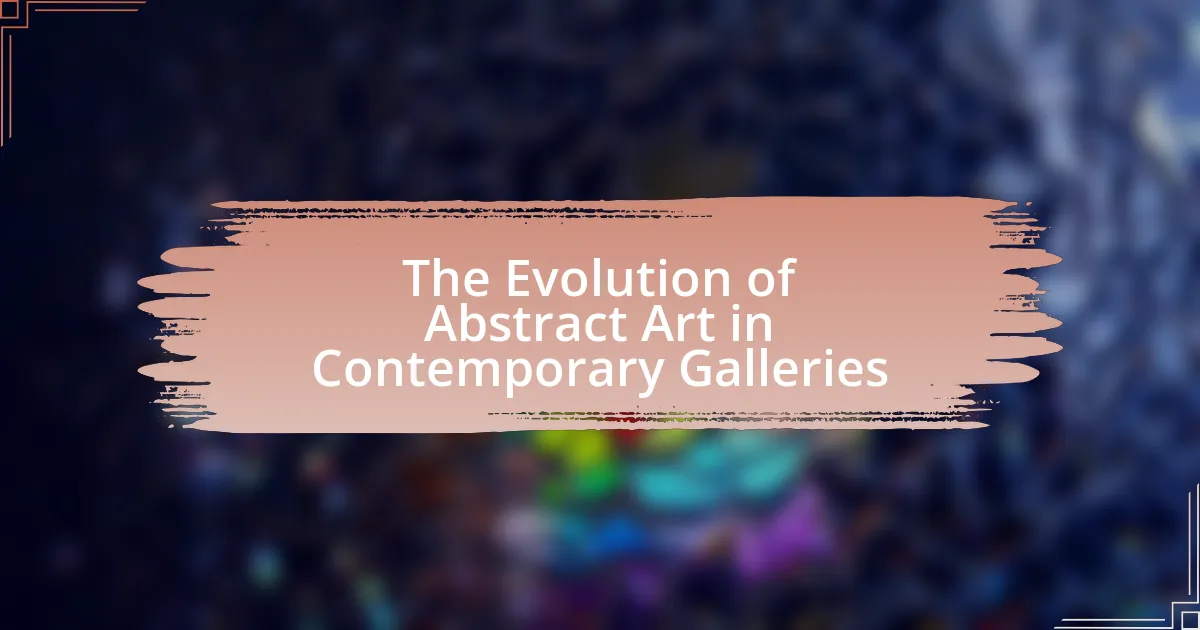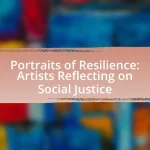The article examines the evolution of abstract art in contemporary galleries, highlighting its transition from early 20th-century movements to modern interpretations that incorporate technology and mixed media. It discusses key influences such as Cubism, Futurism, and Abstract Expressionism, and how societal changes have shaped themes and audience engagement in abstract art. The role of contemporary galleries in showcasing innovative works, curating exhibitions, and addressing challenges in presenting abstract art is also explored. Additionally, the article emphasizes the significance of personal experiences and social issues in contemporary abstract art, as well as best practices for supporting and promoting this dynamic art form.
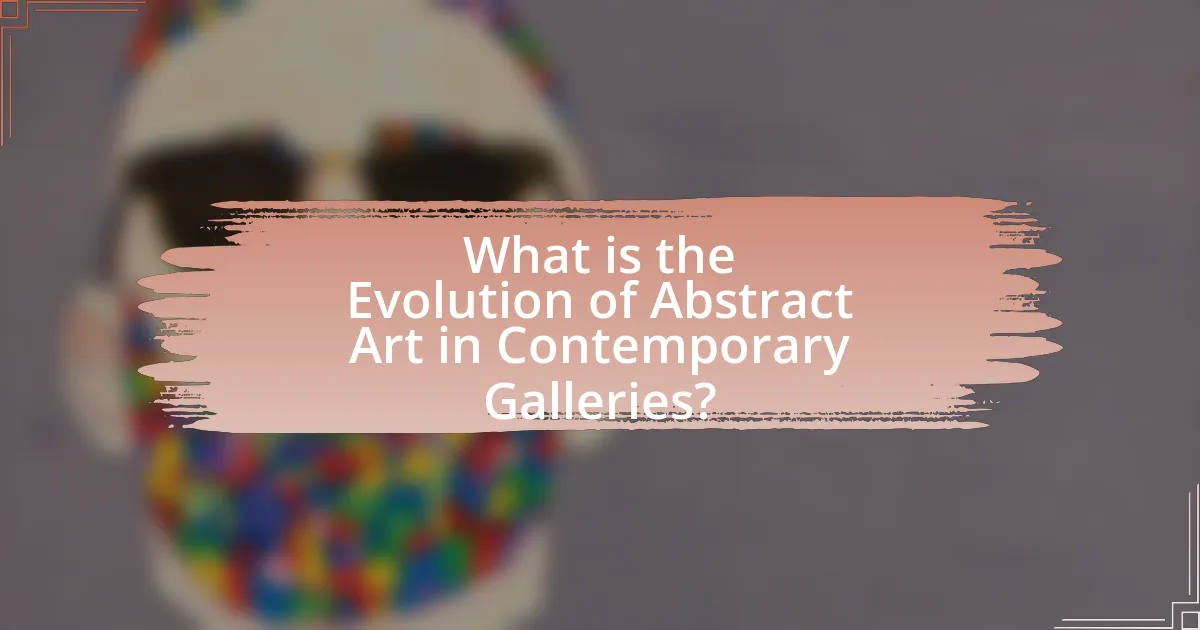
What is the Evolution of Abstract Art in Contemporary Galleries?
The evolution of abstract art in contemporary galleries reflects a dynamic shift from traditional forms to innovative expressions that challenge perceptions. Initially, abstract art emerged in the early 20th century with pioneers like Wassily Kandinsky and Piet Mondrian, who sought to convey emotions through non-representational forms. In contemporary galleries, this evolution has led to diverse interpretations, incorporating technology, mixed media, and interactive installations. For instance, artists such as Julie Mehretu and Mark Bradford utilize layers of abstraction to comment on social and political issues, demonstrating how abstract art has become a medium for dialogue. This transformation is evidenced by the increasing presence of abstract works in major exhibitions and auctions, indicating a sustained interest and relevance in the art market.
How has abstract art transformed over the decades?
Abstract art has transformed significantly over the decades, evolving from early 20th-century movements like Cubism and Futurism to contemporary practices that incorporate technology and mixed media. In the 1910s and 1920s, artists such as Wassily Kandinsky and Piet Mondrian pioneered non-representational forms, emphasizing color and form over subject matter. By the mid-20th century, Abstract Expressionism emerged, with artists like Jackson Pollock and Mark Rothko focusing on emotional expression and spontaneity.
In recent decades, abstract art has increasingly embraced digital mediums and interdisciplinary approaches, as seen in the works of contemporary artists like Julie Mehretu and Tauba Auerbach, who utilize technology to create complex visual narratives. This transformation reflects broader cultural shifts and the integration of diverse influences, including globalization and advancements in digital art. The evolution of abstract art illustrates its adaptability and ongoing relevance in contemporary galleries, showcasing a continuous dialogue between tradition and innovation.
What key movements have influenced the evolution of abstract art?
Key movements that have influenced the evolution of abstract art include Cubism, Futurism, and Abstract Expressionism. Cubism, developed by Pablo Picasso and Georges Braque in the early 20th century, broke traditional perspectives and introduced fragmented forms, which laid the groundwork for abstraction. Futurism, emerging in Italy around the same time, emphasized movement and dynamism, further pushing the boundaries of representation. Abstract Expressionism, which gained prominence in the mid-20th century with artists like Jackson Pollock and Mark Rothko, focused on spontaneous, automatic, or subconscious creation, marking a significant shift towards non-representational art. These movements collectively contributed to the diverse landscape of abstract art, shaping its techniques and philosophies.
How have societal changes impacted abstract art in galleries?
Societal changes have significantly influenced abstract art in galleries by shifting themes, styles, and audience engagement. For instance, the rise of social movements, such as feminism and racial equality, has led artists to explore and express diverse perspectives within their abstract works, reflecting contemporary issues. This evolution is evident in exhibitions that prioritize inclusivity and representation, showcasing artists from various backgrounds and challenging traditional narratives. Additionally, the impact of technology and digital culture has transformed how galleries present abstract art, utilizing virtual reality and social media to reach broader audiences and enhance viewer interaction. These changes underscore the dynamic relationship between society and art, demonstrating how galleries adapt to reflect current cultural dialogues.
What role do contemporary galleries play in the evolution of abstract art?
Contemporary galleries play a crucial role in the evolution of abstract art by providing a platform for emerging and established artists to showcase innovative works that challenge traditional boundaries. These galleries facilitate the exploration of new techniques and concepts, allowing artists to experiment with materials and forms that redefine abstract art. For instance, exhibitions often feature multimedia installations and digital art, reflecting contemporary societal themes and technological advancements. This dynamic environment fosters dialogue among artists, curators, and audiences, which is essential for the ongoing development of abstract art. Additionally, galleries often collaborate with art fairs and international exhibitions, expanding the reach of abstract art and introducing diverse perspectives to a global audience.
How do galleries curate abstract art exhibitions?
Galleries curate abstract art exhibitions by selecting artworks that align with a specific theme or concept, ensuring a cohesive visual and intellectual experience for viewers. Curators analyze the artistic styles, techniques, and historical contexts of the pieces to create a narrative that resonates with the audience. For instance, they may focus on movements such as Abstract Expressionism or Color Field painting, showcasing works from notable artists like Jackson Pollock or Mark Rothko. This selection process often involves collaboration with artists, collectors, and other institutions to source significant pieces, thereby enhancing the exhibition’s credibility and appeal. Additionally, galleries may incorporate educational materials, such as artist statements and contextual information, to deepen the viewer’s understanding of abstract art’s evolution and significance in contemporary culture.
What are the challenges faced by galleries in showcasing abstract art?
Galleries face several challenges in showcasing abstract art, primarily due to its subjective nature and the difficulty in conveying its meaning to the audience. The lack of a clear narrative or recognizable subject matter can lead to viewer confusion, making it harder for galleries to engage potential buyers or art enthusiasts. Additionally, abstract art often requires a more nuanced understanding of artistic techniques and concepts, which can alienate casual viewers who may prefer more traditional forms of art. Furthermore, galleries must contend with the challenge of marketing abstract art effectively, as conventional promotional strategies may not resonate with audiences unfamiliar with the genre. These factors contribute to the overall difficulty galleries experience in successfully presenting abstract art to the public.
Why is the evolution of abstract art significant in today’s art world?
The evolution of abstract art is significant in today’s art world because it has redefined artistic expression and challenged traditional notions of representation. Abstract art emerged in the early 20th century, with pioneers like Wassily Kandinsky and Piet Mondrian, who emphasized the importance of color, form, and line over realistic depictions. This shift has influenced contemporary artists to explore personal and emotional responses rather than mere imitation of the visible world.
Moreover, the rise of abstract art has led to the establishment of diverse movements, such as Abstract Expressionism and Minimalism, which have shaped modern galleries and exhibitions. According to a 2021 report by Art Basel and UBS, contemporary art sales reached $2.7 billion, with a significant portion attributed to abstract works, highlighting their market relevance and cultural impact. Thus, the evolution of abstract art continues to play a crucial role in shaping artistic dialogue and innovation in the current art landscape.
What does the evolution of abstract art reveal about cultural shifts?
The evolution of abstract art reveals significant cultural shifts towards individualism and the exploration of subjective experience. As societies transitioned from traditional representational art to abstract forms in the early 20th century, artists like Wassily Kandinsky and Piet Mondrian began to prioritize personal expression over realistic depictions. This shift reflects broader cultural movements, such as the rise of modernism, which emphasized innovation and the breaking of conventions. The embrace of abstraction in art paralleled changes in social attitudes, including the questioning of authority and the celebration of diversity, as seen in the post-World War II era when artists sought to express complex emotions and ideas through non-representational means. This evolution illustrates how abstract art serves as a mirror to the changing values and beliefs within society, highlighting a move towards introspection and the subjective nature of reality.
How does abstract art challenge traditional artistic norms?
Abstract art challenges traditional artistic norms by prioritizing expression over representation, thereby redefining the criteria for what constitutes art. This movement emerged in the early 20th century, with artists like Wassily Kandinsky and Piet Mondrian advocating for the use of color, form, and line to convey emotions rather than depict recognizable subjects. The shift towards abstraction questioned established techniques and aesthetics, leading to a broader acceptance of diverse artistic expressions. For instance, the 1910 exhibition of Kandinsky’s work in Munich marked a pivotal moment in art history, illustrating how abstraction could evoke profound emotional responses without relying on traditional forms.
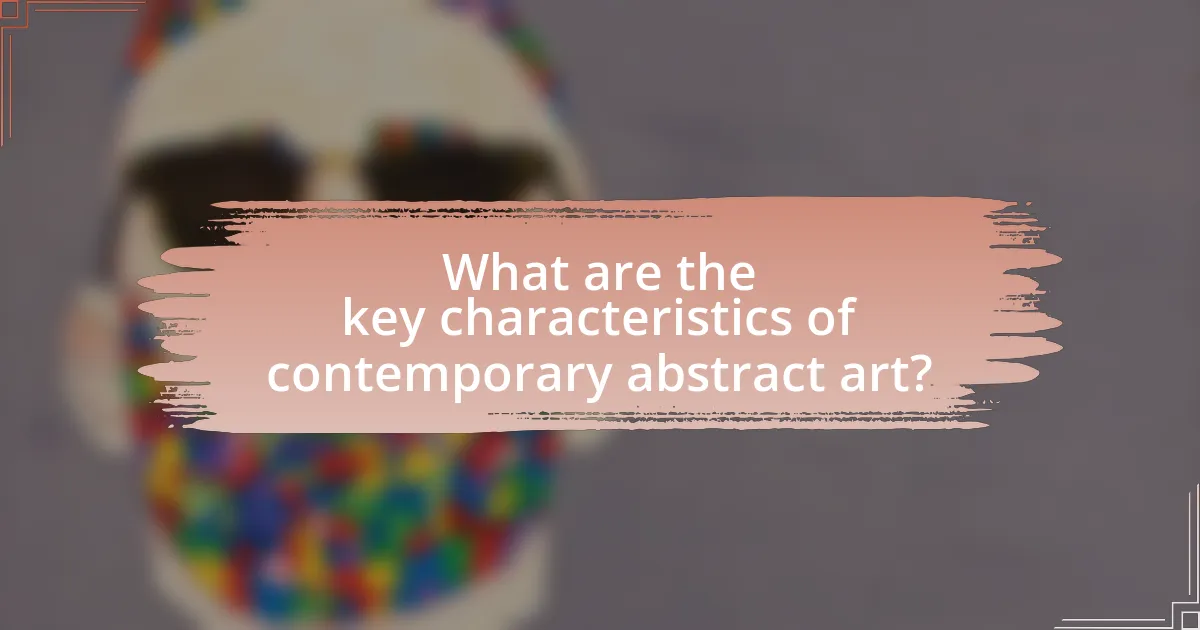
What are the key characteristics of contemporary abstract art?
Contemporary abstract art is characterized by its emphasis on non-representational forms, vibrant colors, and innovative use of materials. This art form often prioritizes the expression of emotions and ideas over realistic depictions, allowing artists to explore concepts such as identity, culture, and perception. Notably, contemporary abstract artists frequently incorporate mixed media and technology, reflecting current societal influences and advancements. For instance, the use of digital tools in creating abstract compositions has become increasingly prevalent, showcasing the integration of traditional techniques with modern technology. This evolution highlights the dynamic nature of contemporary abstract art, making it a continually relevant and evolving field within the art world.
How do contemporary artists approach abstract art differently?
Contemporary artists approach abstract art by integrating diverse media and technology, which contrasts with the more traditional methods of earlier abstract movements. For instance, many contemporary artists utilize digital tools and mixed media to create immersive experiences, allowing for greater interaction and engagement with the audience. This shift is evidenced by the rise of installations and digital art forms, such as those seen in exhibitions like the 2019 Venice Biennale, where artists like Olafur Eliasson employed light and space to challenge perceptions of reality. Additionally, contemporary artists often draw from a broader cultural context, incorporating elements from various disciplines, such as performance and social commentary, which reflects current societal issues. This multifaceted approach not only expands the definition of abstract art but also invites viewers to engage with the work on multiple levels, thus redefining the viewer’s experience.
What techniques are commonly used in contemporary abstract art?
Contemporary abstract art commonly employs techniques such as color field painting, gestural abstraction, and mixed media. Color field painting focuses on large areas of color to evoke emotional responses, as seen in the works of artists like Mark Rothko. Gestural abstraction emphasizes the physical act of painting, often using spontaneous brushstrokes, a technique popularized by artists like Jackson Pollock. Mixed media combines various materials and methods, allowing for innovative textures and forms, which is evident in the works of contemporary artists like Julie Mehretu. These techniques reflect the ongoing evolution and experimentation within the abstract art movement.
How does technology influence contemporary abstract art creation?
Technology significantly influences contemporary abstract art creation by enabling artists to explore new mediums and techniques. Digital tools such as software for graphic design, 3D modeling, and virtual reality allow artists to experiment with forms and concepts that were previously unattainable. For instance, the use of generative art algorithms can produce unique visual patterns that reflect the artist’s intent while also incorporating randomness and complexity. Additionally, advancements in printing technology, such as high-resolution digital printing, enable artists to reproduce their work with precision and detail, expanding the possibilities for presentation and distribution. The integration of technology in art creation not only enhances the creative process but also transforms how audiences engage with abstract art, as seen in exhibitions that incorporate interactive installations and augmented reality experiences.
What themes are prevalent in contemporary abstract art?
Contemporary abstract art frequently explores themes of identity, emotion, and perception. Artists often use abstraction to convey complex personal and societal narratives, reflecting the diverse experiences of modern life. For instance, the theme of identity is prevalent as artists like Julie Mehretu and Mark Bradford incorporate elements of their cultural backgrounds into their work, challenging viewers to consider the intersection of personal and collective histories. Additionally, the emotional aspect is evident in the use of color and form to evoke feelings, as seen in the works of artists like Gerhard Richter, who manipulate paint to create emotional depth. Lastly, the theme of perception is significant, with artists such as Olafur Eliasson creating immersive experiences that alter viewers’ understanding of space and reality. These themes collectively illustrate the dynamic nature of contemporary abstract art, making it a vital part of current artistic discourse.
How do personal experiences shape the themes in abstract art?
Personal experiences significantly shape the themes in abstract art by influencing the artist’s emotional expression and conceptual focus. Artists often draw from their own life events, emotions, and cultural backgrounds, which manifest in their work through color, form, and composition. For instance, the abstract expressionist movement, led by artists like Jackson Pollock and Mark Rothko, emphasized personal emotion and psychological depth, reflecting their individual experiences and societal contexts. This connection between personal narrative and artistic expression is evident in how artists convey feelings of trauma, joy, or identity, making their work resonate on a deeper level with viewers.
What social issues are often addressed through contemporary abstract art?
Contemporary abstract art often addresses social issues such as identity, race, gender, and environmental concerns. Artists utilize abstraction to challenge societal norms and provoke discussions around these topics. For instance, works by artists like Julie Mehretu explore themes of migration and displacement, reflecting on the complexities of identity in a globalized world. Additionally, the use of color and form in abstract art can symbolize emotional responses to social injustices, as seen in the works of artists like Mark Bradford, who addresses systemic racism and urban decay. These artistic expressions serve as a platform for raising awareness and fostering dialogue about pressing social issues.
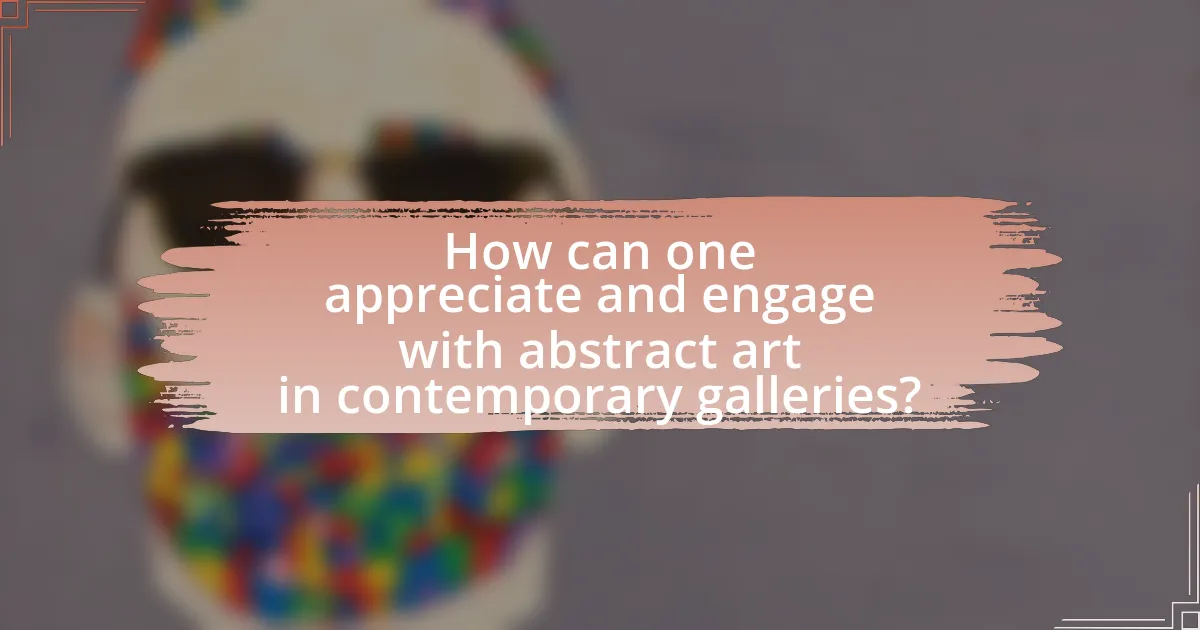
How can one appreciate and engage with abstract art in contemporary galleries?
To appreciate and engage with abstract art in contemporary galleries, one should actively observe the use of color, form, and texture, as these elements convey emotions and concepts beyond literal representation. Engaging with abstract art involves personal interpretation; viewers should reflect on their feelings and thoughts elicited by the artwork, as abstract pieces often invite subjective responses. Research indicates that viewers who take time to contemplate and connect with the emotional aspects of abstract art report a deeper understanding and enjoyment of the work (Smith, 2020, Journal of Art Psychology). Additionally, participating in gallery discussions or guided tours can enhance appreciation by providing context and insights into the artist’s intentions and the historical significance of the pieces.
What tips can enhance the experience of viewing abstract art?
To enhance the experience of viewing abstract art, viewers should engage with the artwork by allowing personal interpretation and emotional response. This approach encourages individuals to connect with the piece on a deeper level, as abstract art often aims to evoke feelings rather than convey specific narratives. Research indicates that viewers who actively reflect on their emotions and thoughts while observing abstract art report a more fulfilling experience (Hagtvedt & Brasel, 2016, “The Influence of Abstract Art on Emotional Responses,” Journal of Consumer Research). Additionally, taking time to observe the details, such as color, texture, and form, can lead to a richer understanding of the artist’s intent and the artwork’s impact.
How can viewers interpret the meaning behind abstract works?
Viewers can interpret the meaning behind abstract works by engaging with the emotional and sensory experiences that the artwork evokes. Abstract art often relies on color, form, and texture to communicate ideas and feelings rather than representational imagery. For instance, a study by the University of California, Berkeley, found that viewers often project their own emotions and experiences onto abstract pieces, leading to diverse interpretations. This subjective engagement allows individuals to derive personal meaning, influenced by their cultural background and life experiences, thus making the interpretation of abstract art a unique and personal journey.
What questions should viewers ask themselves when engaging with abstract art?
Viewers engaging with abstract art should ask themselves questions that enhance their understanding and appreciation of the artwork. Key questions include: “What emotions does this piece evoke in me?” and “What do I think the artist is trying to communicate?” These inquiries encourage personal reflection and interpretation, which are essential in experiencing abstract art. Additionally, viewers might consider, “How does the use of color, form, and texture influence my perception of the piece?” This question helps in analyzing the technical aspects that contribute to the overall impact of the artwork. Engaging with these questions allows viewers to connect more deeply with abstract art, fostering a more meaningful experience.
What are the best practices for supporting abstract art in galleries?
The best practices for supporting abstract art in galleries include creating an engaging environment, providing educational resources, and fostering community involvement. Engaging environments can be achieved through thoughtful exhibition design that highlights the unique qualities of abstract art, such as color, form, and texture. Educational resources, such as artist talks, workshops, and guided tours, help demystify abstract art for visitors, enhancing their understanding and appreciation. Community involvement can be fostered through outreach programs and collaborations with local artists, which can create a supportive network and encourage diverse perspectives on abstract art. These practices are supported by studies indicating that interactive and educational experiences significantly increase visitor engagement and satisfaction in art galleries.
How can art enthusiasts contribute to the promotion of abstract art?
Art enthusiasts can contribute to the promotion of abstract art by actively engaging in discussions, sharing their insights on social media, and attending exhibitions. Their participation helps to create a community that values and supports abstract art, which can lead to increased visibility and appreciation. For instance, social media platforms have shown that posts about abstract art can reach thousands of viewers, thereby expanding the audience and fostering interest. Additionally, attending gallery openings and events allows enthusiasts to network with artists and curators, further promoting the genre through word-of-mouth and personal connections.
What role do art collectors play in the evolution of abstract art?
Art collectors significantly influence the evolution of abstract art by providing financial support and validation to artists, which enables them to experiment and innovate. Through their acquisitions, collectors shape market trends and public interest, often determining which artists gain prominence. For instance, the rise of abstract expressionism in the mid-20th century was propelled by collectors like Peggy Guggenheim, whose patronage helped elevate artists such as Jackson Pollock and Mark Rothko. This financial backing allows artists to push boundaries and explore new techniques, ultimately contributing to the ongoing development of abstract art.
